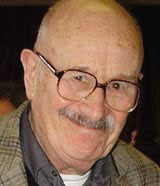Comedy of errors
David Bernstein finds that mistakes breed invention and the results reap far more interesting rewards than careful planning.

David Bernstein finds that mistakes breed invention and the results reap far more interesting rewards than careful planning
I wonder if you were as confused as I was by Gregor Jackson’s contribution to Inspired (DW 1 September)? Having dismissed various candidate inspirations, he opted for ‘the more abstract, less tangible one… that is woven into the fabric of my business… the dynamics of creating a team of talented individuals [symbolised by the illustration]’. The adjacent picture – interacting swirls of green and yellow against a red background – did not immediately convey the idea of people. It was indeed dynamic and seemed, the longer I looked at it, to illustrate his metaphor of a design team as an orchestra and its end product a ‘design symphony’.
However, when I reached his concluding sentence, ‘Back to “art inspirations”/ my eldest daughter’s paintings are my latest addition to the list’, I realised that there were two adjacent pictures and that I had understood the immediately adjacent, marked with the figure one, to illustrate the initial comment. The second illustration, marked two, a row of cut-out linked paper figures, certainly conveyed people, but none of the creative dynamism of the other illustration, his child’s drawing.
I occasionally suffer from caption dyslexia. For example, in art galleries where slugs of text are placed together and apart from the relevant artwork, I am determined to force a connection between the text and the image. The viewer as co-elucidator, detecting associations and becoming what Arthur Koestler called the creator’s accomplice.
Creativity is often inspired by accident, by the chance juxtaposition of elements. When I run creative workshops, I try to encourage random collision. One technique involves the use of a collection of totally unrelated slides. The teams – eyes shut – select four slides each and then prepare a one-minute presentation, using this material coherently and imaginatively as if it had been specially commissioned. In another game, I set an advertising brief and 15 minutes later provide the team with a magazine. ‘The answer’s in there,’ I say. As far as I’m concerned, it isn’t, but as far as the team is concerned, it has to be… and sure enough it is!
I was reading an H G Wells adventure story. The hero was ‘stumbling over heaps of memory’. I relished the phrase which described how I feel when I can’t quite remember something. I returned to the text and re-read it/ ‘stumbling over heaps of masonry’. My mistake – and now my image.
Often your immediate reaction to an innovative thought is to seek verification. Has the progenitor made a mistake? Ideas generate a variety of reactions – disbelief, incomprehension, laughter, contempt, silence.
Error can breed invention. Penicillin was the result of a ruined experiment, Post-it Notes that of a failed glue. A spoiled batch of toilet tissue – the paper was heavy and wrinkled – was the origin of Scot Towels. In 1878 Procter and Gamble was surprised by requests for more of its floating soap. ‘A worker left for lunch without turning off the mixer in a vat of white soap, causing the batch to incorporate more than the customary amount of air.’*
Thomas Watson Senior, grand old man of IBM, upon being told that the error rate in a plant had risen, replied, ‘Make more errors.’
* Innovative Genius. Library of Curious and Unusual Facts. Time-Life 1991.
-
Post a comment




